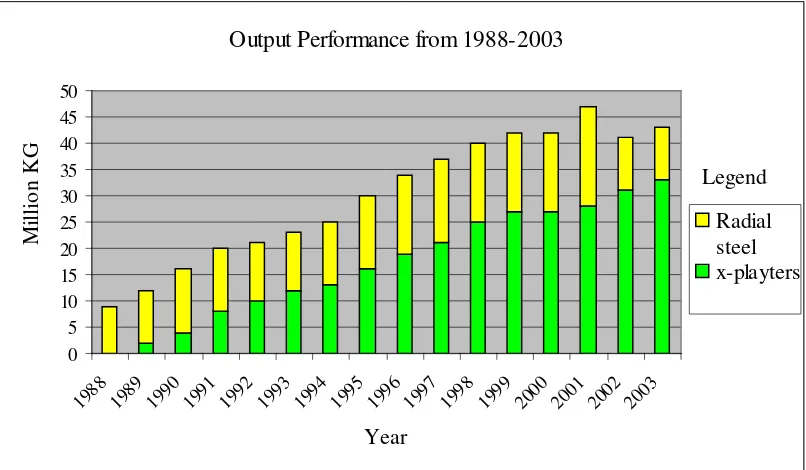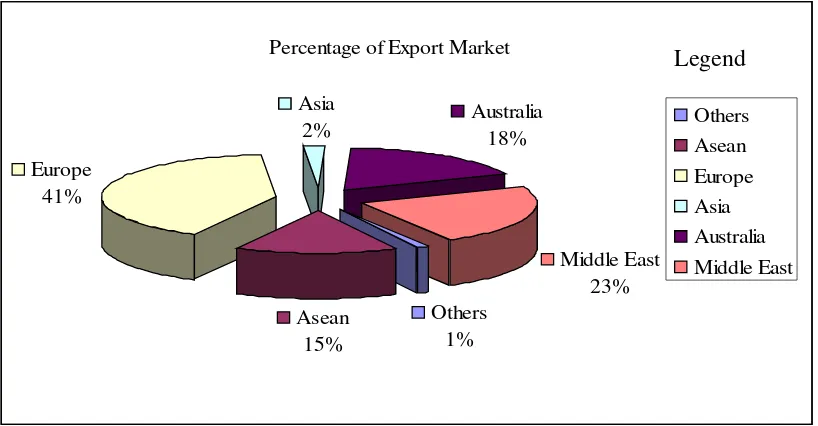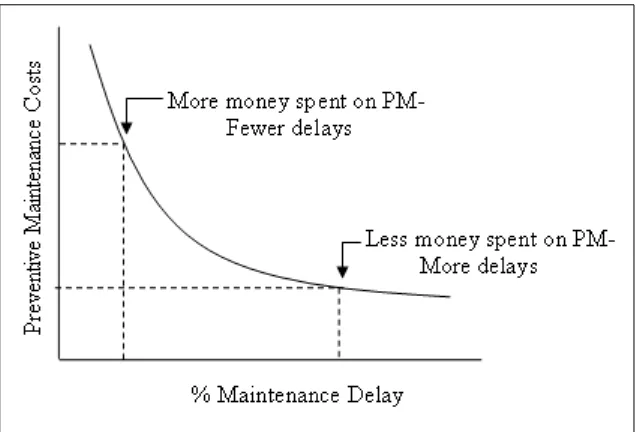THE IMPLEMENTATION OF TOTAL PRODUCTIVE
MAINTENANCE (TPM) AT HIGH VOLUME COMPANY
MAR’EMAZAIRY BIN OMAR
UNIVERSITI TEKNIKAL MALAYSIA MELAKA
THE IMPLEMENTATION OF TOTAL PRODUCTIVE
MAINTENANCE (TPM) AT HIGH VOLUME COMPANY
Thesis submitted in accordance with the requirements of Universiti Teknikal Malaysia Melaka for the Bachelor Degree of Manufacturing Engineering in
Manufacturing Process
By
MAR’EMAZAIRY BIN OMAR
SULIT
TERHAD
√ TIDAK TERHAD
(Mengandungi maklumat yang berdarj ah keselamat an at au kepent ingan Malaysia yang t ermakt ub di dalam AKTA RAHSIA RASMI 1972)
(Mengandungi maklumat TERHAD yang t elah dit ent ukan oleh organisasi/ badan di mana penyelidikan dij alankan)
(TANDATANGAN PENULIS)
UNIVERSITI TEKNIKAL MALAYSIA MELAKA
JUDUL: THE IMPLEMENTATION OF TOTAL PRODUCTIVE MAINTENANCE (TPM) AT HIGH VOLUME COMPANY
SESI PENGAJIAN: 2006/ 2007
Saya __________________MAR’ EMAZAIRY BIN OMAR____________________
mengaku membenarkan t esis (PSM/ Sarj ana/ Dokt or Falsaf ah) ini disimpan di Perpust akaan Universit i Teknikal Malaysia Melaka (UTeM) dengan syarat -syarat kegunaan sepert i berikut :
1. Tesis adalah hak milik Universit i Teknikal Malaysia Melaka.
2. Perpust akaan Universit i Teknikal Malaysia Melaka dibenarkan membuat salinan unt uk t uj uan pengaj ian sahaj a.
3. Perpust akaan dibenarkan membuat salinan t esis ini sebagai bahan pert ukaran ant ara inst it usi pengaj ian t inggi.
4. **Sila t andakan (√)
DECLARATION
I hereby, declared this thesis entitled “The Implementation of Total productive Maintenance (TPM) at High Volume Company” is the result of my own research except
as cited in references.
Signature : ………..
Author’s Name : ………
ABSTRACT
ABSTRAK
Laporan ini disediakan bagi menerangkan hasil keputusan daripada kajian tentang Senggaraan Produktif Menyeluruh (TPM) di syarikat yang mempunyai kapasiti pengeluaran yang tinggi. Syarikat tersebut ialah Continnental SimeTyres (CST) yang terletak di Alor Star, Kedah. Kajian ini akan meliputi aspek-aspek cabaran, faedah, batasan dan lain-lain isu yang berkaitan di dalam pelaksanaan TPM. Data diambil dari pelbagai kaedah termasuklah secara pemerhatian dan temubual. Selain itu, borang soal jawab juga diedarkan kepada pekerja-pekerja yang terlibat di dalam perlaksanaan TPM. Data yang terkumpul kemudiannya dianalisa menggunakan perisian Statistica1 Package
for Social Science (SPSS). Hasil kajian mendapati terdapat beberapa isu mengenai
pelaksanaan TPM dan perlu diberi perhatian dalam usaha untuk mencapai kejayaan di dalam pelaksanaan TPM
DEDICATION
To my beloved family especially my mother and father, Puan Asma Bt Salleh and En.Omar B.Saad, I thank my parents for their continuous support to me in performing
this diffilcult task, and the journey does not end here.
To my supervisor, En Wan Hasrulnizam B. Wan Mahmood for being receptive and critical, and challenging me to be a better student
ACKNOWLEDGMENT
In the name of Allah S.W.T, the creator of all creations, all praises to Him, the Most Merciful the Most Blessing. Alhamdulillah I had completed this study successfully.
A million thankful to En Wan Hasrulnizam B. Wan Mahmood, my respectable advisor for his advices and guidance while preparing this study with his critical suggestions. I would also like to express my appreciation and thanks to my second examiner, Cik Zaleha Bt Mustafa.
TABLE OF CONTENTS
List of Figures ...ix
List of Tables ………...…...……...v
List of Abbreviations……….……xi
1. INTRODUCTION...1
1.1 Introduction ...1
1.2 Problem Statement ...2
1.3 Objective...3
1.4 Scope of Study...3
1.5 Company Background...3
1.6 Benefit of Study...5
2.0 LITERATURE REVIEW...7
2.1 Introduction to TPM...7
2.2 Importance of TPM...8
2.3 Definition of TPM...10
2.4 Type of Maintenance...10
2.4.1 Preventive Maintenance...11
2.4.1.1 Scheduled Maintenance...13
2.4.1.2 Monitored Maintenance...13
2.4.1.3 Cost of PM vs Cost Equipment...14
2.4.1.4 Inspection Intervals...15
2.4.3 Renovative Maintenance...18
2.5 TPM Obstacles...19
2.6 Critical Success Factor (CSF) in Implementing of TPM...21
2.7 TPM journey at CST...22
2.8 The Implementation of TPM at CST...24
2.9 Standard Operation Procedure for Preventive Maintenance at CST...26
2.9.1 PM Procedure Outline...26
2.9.2 PM Procedure Details...27
2.9.3 PM Records...28
2.10 Standard Operation Procedure for Breakdown Maintenance at CST...30
2.10.1 Breakdown Maintenance Procedure...30
2.10.2 Procedure Details...30
2.10.3 Records...32
2.11 How TPM Attack Machine Lost at CST...32
2.12 TPM Focuses on Machine Component Equipment...34
2.13 Current Issue of TPM at CST...35
2.13 The concepts of constraints...36
2.14 The Equipment aging paradigm...38
2.15 Previous Case Study...43
2.15.1 TPM Process...44
2.15.2 TPM Co-ordinators...45
2.15.3 Strategic Objective...46
3. METHODOLOGY...47
3.1 Introduction...47
3.2 Planning of the Study...47
3.3 Data Planning...49
3.3.1 The Questionnaire...48
3.3.2 Interview...50
3.4 Data Analysis...51
3.4.1 Mean and Standard Deviation………51
4. RESULT AND DISCUSSION………..…….53
4.1 Introduction………..53
4.2 Analysis of Respondent’s Information……….54
4.3 Analysis of the TPM implementation at CST………..56
4.3.1 Considering stage/implementation of TPM at CST………...57
4.3.2 The Benefits of TPM Implementation………....59
4.3.3 The Limitations of TPM Program………..…61
4.3.4 The Challenge of the TPM before implementation at CST………62
4.3.5 The Current Challenge of the TPM Implementation at CST……….63
4.3.6 The Require Elements to Improve the TPM implementation Plan………..…………..64
5. CONCLUSION………...………65
5.1 Introduction……….……….65
5.2 Conclusion………65
5.3 Recommendation………..66
REFRENCES...68
APPENDIXES
LIST OF FIGURES
1.1 Graph Performance of CST from 1998 until 2003………...2
1.2 The Percentage of Export Market for CST………...4
2.1 Graph Cost-versus-delay curve……….………….10
2.2 Graph Control limit versus wear………13
2.3 Preventive Maintenance timing……….16
2.4 Graph Corrective maintenance effect on equipment availability………...18
2.5 Graph Cost effective of renovative maintenance………...…………19
2.6 Cause and effect diagram a generic model of factors affecting successful implementation of TPM…………...……….22
2.7 Important elements to Total Productive Maintenance………23
2.8 The measure of TPM implementation………24
2.9 Organization Structure………25
2.11 Iceberg analogy to show the hidden minor machine defect………...33
2.11 (a) Aging Performance of Poorly Maintained Machined………38
2.11(b) Aging machine performance with TPM methods applied………..39
2.12 Graph for breakdown machine for October 2005………...40
2.13 Graph for the total losses for PCR and LTR tyre………...………41
2.14 Graph for PCR Moulding Output for October 2005 Plan Vs Actual ……...… 41
3.1 The Flow Chart of Study Planning………...48
LIST OF TABLES
2.1 PM Procedure Outline………..26
2.2 PM Records………..28
2.3 PM schedule for April, 2006………29
2.4 Breakdown Maintenance Procedure Outline…………..………..30
2.5 Breakdown Records………..32
2.6 Example of Daily Moulding and Losses report (CST Daily Report)…………...42
3.1 Gantt Chart for Study Planning………52
4.1 Respondent’s Sex……….54
4.2 Respondent’s Positions……….55
4.3 Durations of Employments………...……....55
4.4 Respondent’s Departments………...56
4.5 Analysis of the considering stage of TPM at CST………..….……58
4.6 Analysis of the Benefit from the Implementation of TPM………...60
4.7 Analysis of the Limitations of TPM Program………..61
4.8 Analysis of the TPM Challenge before Implementation at CST………..…62
4.9 Analysis of the Current Challenge of TPM at CST………..63
LIST OF ABBREVIATIONS
AFTA - ASEAN Free Trade Area CGS - Centre Good Store
CMF - Curing, Moulding and Finishing CST - Continental Sime Tyres Sdn. Bhd.
ECE - United Nations Economic Commission for Europe ISO - International Organization for Standardization JIPM - Japan Institute of Plant Maintenance
MV - Missing Value
PM - Preventive Maintenance
pp - Page
SD - Standard Deviation
SIRIM - Standards and Industrial Research Institute of Malaysia SOP - Standard Operation Procedure
SPSS - Statistical Package for the Social Science TPM - Total Productive Maintenance
CHAPTER 1
INTRODUCTION
1.1 Introduction
Globalization and economic turbulence have increased pressure on manufacturing firms to perform in cost efficient ways that are able to satisfy the ever changing need of their customers. Costs of production are often linked to maintenance related activities (maintenance labor and maintenance costs) and cost incurred due to the production losses (Blanchard, 1997). Bamber et al. (1997) reported that effective maintenance strategy significantly adds value to the production activities and subsequent business. One of the well-known innovative maintenance programs adopted by manufacturers is the Total Productive Maintenance (TPM). It was proven as one of the innovative approach for maintenance since it help to optimizes equipment effectiveness, eliminates breakdown and promotes autonomous maintenance via day today activities involving the firm’s total workforce. Since it was introduced a few decades ago, it has attracted many companies in multi-industries to implement it.
increase their productivity. The next chapter will details the performance of CST after the TPM implementation.
However, CST still have to face of many challenges in order to maintain the TPM program such as failure factor, less expertise of maintenance crew, the increase of the production cost and some barriers from the management. CST is still looking for the best way to improve the implementation of TPM to achieve their mission and vision to be successful TPM company.
Output Performance from 1988-2003
Figure 1.1: Graph for Output Performance of CST from 1998 until 2003 (CST Annual Report 2003)
1.2 Problem Statement
improve the TPM implementation plan. In addition it also will show the current state of TPM implementation at CST
1.3 Objective
The objectives of this study are:
1. To identify any related issue of TPM implementation in terms of the benefits, challenges, limitations and the require elements to improve the TPM implementation plan.
2. To study the current stage of TPM implementation at high volume company.
1.4 Scope of Study
This study is only a case study of TPM implementation at CST. This study is performed to identify the benefits, challenges, limitations, the require elements to improve TPM implementation and to review the current state of TPM implementation. The study was conducted from November 2006 until Mac 2007. For data gathering, only observation, interview and questionnaire survey for 56 respondents were used. Some of the data was analyzed by using SPSS programming version 13.0. The result may not applicable for other company.
1.5 Company Background
Berhad. On 2nd November, 1988 the company changed its name to Sime Tyres International (M) Sdn.Bhd. STI also signed a Technical Co-operation Agreement with Sumitomo Rubber Industries of Japan (DUNLOP JAPAN) in 1987. This move is to ensure that STI has access to the latest tyre production technology and design. To ensure that the Sime Darby Tyre Group will be better equipped to meet the new challenges as well as capitalizing on the opportunities in the new environment of AFTA and WTO, Sime Darby also signed another agreement with Continental AG giving Continental a stake in SDC Tyre. On 1st October 2003, another agreement was signed with Continental AG giving Continental 51% share in SDC Tyre which in effect resulting the name of the holding company to be changed to Continental Sime Tyre Sdn Bhd (CST).
Currently the Sales and Marketing activity is being handled by the subsidiary company Continental Sime Tyre Marketing Sdn.Bhd. that is located in Petaling Jaya. CST exports to over 58 countries worldwide. It has over 400 dealer outlets domestically (Peninsular and East Malaysia). Figure 1.2 shows their export market.
Percentage of Export Market
From the chart, it can be seen that CST’s major export market is from Europe with 41 %, due to their high market demand and high standard of living. The second runner is from the Middle East with 23%, and then follows up by Australia with 18%, Asean with 15%, Asia with 2% and lastly 1% for the other markets. This data proves that CST has a big potential in the market worldwide.
Since CST was established in 1979 with a work force of only a few hundreds of employees, after over 20 years of progress, it has grown to be the largest private company in Alor Star with about 1600 employees producing motorcycle, scooter, passenger car and light truck commercial tyres. It had also been awarded ISO 9002 for Retread Plant (SIRIM), Malaysian Standard MS 149 and 1394 (SIRIM), European Standards ECE 30, ECE 54, ECE 75 (VCA and TUV), ISO 9002 (SIRIM), ISO 14001 (SIRIM) and so on from the nationwide and international.
Since they implemented TPM a few years ago, there are some improvements in their company performance. However, they are still facing some related issues regarding The TPM implementation. The next chapter will be details of all these aspects.
1.6 Benefit of the Study
The benefits of this study are:
CHAPTER 2
LITERATURE REVIEW
2.1 Introduction to TPM
In the world of business today, customers expect manufactures to provide excellent quality, reliable delivery, and competitive pricing (Borris, 2006). This demands that the manufacture’s machine and processes are highly reliable. Certainly, with manufacturing, process and service industries becoming progressively dependent on the reliability of fewer but more sophisticated machine and process while poor equipment operating performance is no longer affordable or acceptable. The overall effectiveness of the machine, equipment and process is paramount to provide consistency of product quality and supply at a realistic price.
Some word class Japanese companies recognized over twenty years ago that the effective application of modern technology can only be achieved through people, starting with the operators of that technology, and not through system alone (Wilmot, 2000). Total Productive Maintenance is a tool to maximize the effectiveness of the equipment by setting and maintaining, the optimum relationship between people and machines (Wilmot, 2000).
Distinguished Plant Award (The TPM Prize) from the Japan Institute of Plant Maintenance (JIPM). Nippondenso was the first plant to receive the award as the result of implementing TPM, and this marked the beginning of JIPM’s association with the improvement methodology. Eventually Seiici Nakajima a vice chairman of JIPM, known as the father of TPM as he provided implementation support to hundred of plants, mostly in Japan.
Nakajima describes TPM as “productive maintenance carried by all employees through small group activities.” He considers it an equal partner to total quality management in the attainment of world-class manufacturing (Ireland, 2001). According to TPM principles, the responsibility for optimizing equipment lies not just with the main tenancy department, but also with all plant personnel. Furthermore, TPM can be say as a plant improve methodology which enabling continuous and rapid improvement of the manufacturing process through use of employee involvement, employee empowerment, and closed-loop measurement of result (Nakajima, 1989).
2.2 Importance of TPM
by implementing TPM. The implementation of TPM if intertwine with other initiatives causing a confounding impact.
Meanwhile, Adler and Shenhar (1990)were indicated that, companies that develop their technological base were able to capitalize on technology’s ability to make a positive contribution to performance. TPM can improve the technological base of a company by enhancing equipment technology and improving the skills of employees. Furthermore, TPM helps to improve the organizations the capabilities by enhancing the problem-solving skills of individuals and enabling learning across various functional areas (Ferrari et al. 2005). Furthermore, refer to Willmott, 2000, was stated there is seven useful definitions and benefits of implementing TPM in a company as below.
1. Maximized efficiency of equipment leading through participation of all employees.
2. Improved reliability of equipment leading to improved product quality and equipment productivity
3. Economical use of equipment throughout its total service life.
4. Operators trained and equipped to perform minor but essential asset care of their machines.
5. Increased utilization of skilled trades in higher technical areas and more diagnostic work
6. Practical and effective total quality team working example aimed at equipment improvement and maintenance prevention.
2.3 Definition of TPM
Willmot (2000), was described TPM as enabling tool to maximize the effectiveness of equipment by setting and maintaining the optimum relationship between people and machines. The father of TPM, Nakajima who has given the original approach of its application, defined TPM as productive maintenance carried out by all employees through small group activities and can be viewed as equipment maintenance performed on a company-wide basis (Bamber, 1999). TPM is thus a method for bringing about change. It is a set of standard activities that can lead to improved management of plant assets when properly performed by individuals and teams (Robinson and Ginder, 1995). Philosophically, TPM resembles total quality management (TQM) in several aspects, such as (Nanta et al, 2005)
1. Total commitment to the program by upper level management is required, 2. Employees must be empowered to initiate corrective action, and
3. A long-range outlook must be accepted as TPM may take a year or more to implement and is an on-going process. Changes in employee mind-set toward their job responsibilities must take place as well. Total productive maintenance (TPM) is the systematic execution of maintenance by all employees through small group activities (Venkatesh, 2003).
The two main goals of TPM are to develop optimal conditions for the workshop as a human machine system and to improve the overall quality of the workshop environment.
2.4 Type of Maintenance
iii. Breakdown iv. Corrective
v. Renovative.
This section will be describe briefly all of this type of maintenance.
2.4.1 Preventive Maintenance (PM)
Preventive maintenance is a philosophy, not just a term. It is rapidly replacing common maintenance practices in competitive industry today. Without this type of program ingrained into an organization, maintenance costs become excessive. A typical cost-versus-delay cure is illustrated in Figure 2.1. To cover this cost, the price of the manufactured product must be raised. Such a rise in price will present the manufactures from being competitive in the marketplace.


